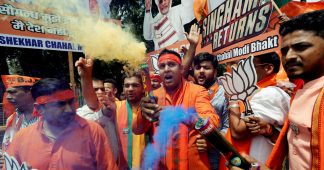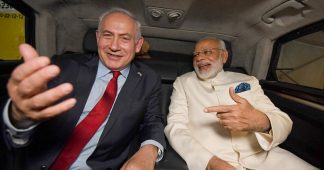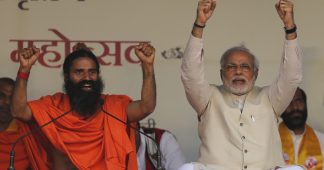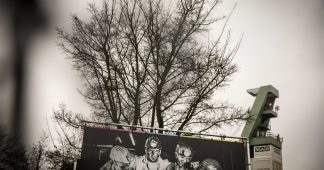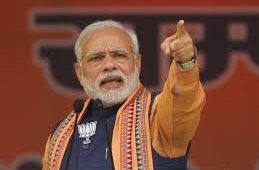29 January 2019
In June 2018, Shivam Shankar Singh, a former data analyst with the Bharatiya Janata Party, wrote a post on the online blogging platform Medium, titled “Why I am resigning from BJP.” In it, he said he took the decision to leave the party as “the negatives of this Narendra Modi and Amit Shah government now outweigh the positives for me.”
Singh worked for the BJP ahead of the assembly elections in Manipur and Tripura, held in 2017 and 2018 respectively. He used data to help chalk out election strategies and target voter-groups through social media. During this time, he wrote, he noticed that the BJP was “spreading some specific messages with incredibly effective propaganda.” He also noticed drastic differences between what the party promised and what it was delivering. Singh began to grow disillusioned with the party. He wrote in his post that the BJP was “pushing the national discourse in a dark corner.”
Singh is now working with the mahagathbandhan, a grand coalition of political parties in Bihar, which opposes the BJP. Earlier this month, Tushar Dhara, a reporting fellow at The Caravan, met him in Delhi. Singh detailed how the BJP used technology to fuel casteist and communal strife to win elections. An edited excerpt from the conversation is reproduced below.
When I first campaigned for the BJP in 2013, there was a narrative about corruption in the country as the 2G, Coalgate, Commonwealth scams had just come to light. Modi presented himself as a great administrator, and at that time, that is what the country was looking for. There was a group set up by the election strategist Prashant Kishore, called Citizens for Accountable Governance. Young professionals from technology and consultancy services, such as KPMG and Ernst & Young, had also left their jobs and joined the CAG to work for Modi’s campaign.
That is the background in which I joined the BJP. I worked for them informally—wrote a few articles and social media posts. The BJP’s data set-up was very strong in 2014. But the structure soon collapsed because the party felt that they had won the election because of Modi. The party’s opinion was that data was not needed. Then something major happened—in 2015, it lost the assembly elections in Delhi and Bihar. The prime minister went to Bihar and said at a rally, “Have you got electricity? Have you got roads?” He expected people to say no, but the crowd said, “Yes!” Even a basic survey would have told you to not raise this issue. The BJP ran blind and lost miserably. This is when they started to build their data structure again. By 2016, they became strong again.
That year, I joined Kishor’s political advocacy group, the Indian Political Action Committee, and worked in Punjab for for a few months. [For the then upcoming Punjab legislative assembly election, the IPAC was campaigning for the Congress.]The perception was that the Congress’s chief ministerial candidate Amarinder Singh, who was called a “Maharaja,” is lazy and does not work too hard. The Congress’s biggest weakness has been that their cadre does not exist in most places and where it does, it does not work because they are not emotionally driven.
In June 2018, Shivam Shankar Singh, a former data analyst with the Bharatiya Janata Party, wrote a post on the online blogging platform Medium, titled “Why I am resigning from BJP.” In it, he said he took the decision to leave the party as “the negatives of this Narendra Modi and Amit Shah government now outweigh the positives for me.”
Singh worked for the BJP ahead of the assembly elections in Manipur and Tripura, held in 2017 and 2018 respectively. He used data to help chalk out election strategies and target voter-groups through social media. During this time, he wrote, he noticed that the BJP was “spreading some specific messages with incredibly effective propaganda.” He also noticed drastic differences between what the party promised and what it was delivering. Singh began to grow disillusioned with the party. He wrote in his post that the BJP was “pushing the national discourse in a dark corner.”
Singh is now working with the mahagathbandhan, a grand coalition of political parties in Bihar, which opposes the BJP. Earlier this month, Tushar Dhara, a reporting fellow at The Caravan, met him in Delhi. Singh detailed how the BJP used technology to fuel casteist and communal strife to win elections. An edited excerpt from the conversation is reproduced below.
When I first campaigned for the BJP in 2013, there was a narrative about corruption in the country as the 2G, Coalgate, Commonwealth scams had just come to light. Modi presented himself as a great administrator, and at that time, that is what the country was looking for. There was a group set up by the election strategist Prashant Kishore, called Citizens for Accountable Governance. Young professionals from technology and consultancy services, such as KPMG and Ernst & Young, had also left their jobs and joined the CAG to work for Modi’s campaign.
That is the background in which I joined the BJP. I worked for them informally—wrote a few articles and social media posts. The BJP’s data set-up was very strong in 2014. But the structure soon collapsed because the party felt that they had won the election because of Modi. The party’s opinion was that data was not needed. Then something major happened—in 2015, it lost the assembly elections in Delhi and Bihar. The prime minister went to Bihar and said at a rally, “Have you got electricity? Have you got roads?” He expected people to say no, but the crowd said, “Yes!” Even a basic survey would have told you to not raise this issue. The BJP ran blind and lost miserably. This is when they started to build their data structure again. By 2016, they became strong again.
That year, I joined Kishor’s political advocacy group, the Indian Political Action Committee, and worked in Punjab for for a few months. [For the then upcoming Punjab legislative assembly election, the IPAC was campaigning for the Congress.]The perception was that the Congress’s chief ministerial candidate Amarinder Singh, who was called a “Maharaja,” is lazy and does not work too hard. The Congress’s biggest weakness has been that their cadre does not exist in most places and where it does, it does not work because they are not emotionally driven.
But things changed with an expensive and energetic campaign, “Punjab da Captain”—Punjab’s Captain. The campaign did two things. Firstly, it transformed Singh from a “Maharaja” to a “Captain.” Secondly, it took him to every constituency, which convinced the party cadre that he is not that disconnected from the ground—the cadre became emotionally driven. After the stint in Punjab, I realised that I am interested in politics, not just consultancy and branding.
I then got in touch with Ram Madhav—the national general secretary of the BJP. He asked me to move to Manipur for the assembly elections in the state, scheduled to be held in 2017. There was absolutely nothing there—no office, no party structure. We hired graphic designers, researchers, built a campaign team and commissioned some surveys. Then all the emotional issues started to go against the BJP. They could not commit on inner-line permits; the blockade on Manipur that had been enforced at the time; and a secret accord with the National Socialist Council of Nagaland (Isak-Muivah). The BJP needed 31 seats, but they won 21. In March 2017, they formed the government with the help of smaller parties.
After that, I came back to Delhi and started profiling constituencies using data, beginning the exercise with the northeast. The idea was for a campaign to yield the maximum return on investment—if the BJP wanted to win a constituency, these were the booths to focus on, and in the constituencies where the possibility of winning was less, it should not put in effort on the booths there.
We collected data regarding three previous parliament and assembly elections from the Election Commission and combined it to see the trend of votes. In the northeast, the BJP did not exist, the Congress and regional parties did. The analysis showed us which booths in Tripura were against the Communist Party of India (Marxist), which was then ruling the state. We combined the analyses with the socio-economic, caste and survey data. We then conducted focus-group discussions to see which caste and tribe was voting for whom.
In June 2018, Shivam Shankar Singh, a former data analyst with the Bharatiya Janata Party, wrote a post on the online blogging platform Medium, titled “Why I am resigning from BJP.” In it, he said he took the decision to leave the party as “the negatives of this Narendra Modi and Amit Shah government now outweigh the positives for me.”
Singh worked for the BJP ahead of the assembly elections in Manipur and Tripura, held in 2017 and 2018 respectively. He used data to help chalk out election strategies and target voter-groups through social media. During this time, he wrote, he noticed that the BJP was “spreading some specific messages with incredibly effective propaganda.” He also noticed drastic differences between what the party promised and what it was delivering. Singh began to grow disillusioned with the party. He wrote in his post that the BJP was “pushing the national discourse in a dark corner.”
Singh is now working with the mahagathbandhan, a grand coalition of political parties in Bihar, which opposes the BJP. Earlier this month, Tushar Dhara, a reporting fellow at The Caravan, met him in Delhi. Singh detailed how the BJP used technology to fuel casteist and communal strife to win elections. An edited excerpt from the conversation is reproduced below.
When I first campaigned for the BJP in 2013, there was a narrative about corruption in the country as the 2G, Coalgate, Commonwealth scams had just come to light. Modi presented himself as a great administrator, and at that time, that is what the country was looking for. There was a group set up by the election strategist Prashant Kishore, called Citizens for Accountable Governance. Young professionals from technology and consultancy services, such as KPMG and Ernst & Young, had also left their jobs and joined the CAG to work for Modi’s campaign.
That is the background in which I joined the BJP. I worked for them informally—wrote a few articles and social media posts. The BJP’s data set-up was very strong in 2014. But the structure soon collapsed because the party felt that they had won the election because of Modi. The party’s opinion was that data was not needed. Then something major happened—in 2015, it lost the assembly elections in Delhi and Bihar. The prime minister went to Bihar and said at a rally, “Have you got electricity? Have you got roads?” He expected people to say no, but the crowd said, “Yes!” Even a basic survey would have told you to not raise this issue. The BJP ran blind and lost miserably. This is when they started to build their data structure again. By 2016, they became strong again.
That year, I joined Kishor’s political advocacy group, the Indian Political Action Committee, and worked in Punjab for for a few months. [For the then upcoming Punjab legislative assembly election, the IPAC was campaigning for the Congress.]The perception was that the Congress’s chief ministerial candidate Amarinder Singh, who was called a “Maharaja,” is lazy and does not work too hard. The Congress’s biggest weakness has been that their cadre does not exist in most places and where it does, it does not work because they are not emotionally driven.
But things changed with an expensive and energetic campaign, “Punjab da Captain”—Punjab’s Captain. The campaign did two things. Firstly, it transformed Singh from a “Maharaja” to a “Captain.” Secondly, it took him to every constituency, which convinced the party cadre that he is not that disconnected from the ground—the cadre became emotionally driven. After the stint in Punjab, I realised that I am interested in politics, not just consultancy and branding.
I then got in touch with Ram Madhav—the national general secretary of the BJP. He asked me to move to Manipur for the assembly elections in the state, scheduled to be held in 2017. There was absolutely nothing there—no office, no party structure. We hired graphic designers, researchers, built a campaign team and commissioned some surveys. Then all the emotional issues started to go against the BJP. They could not commit on inner-line permits; the blockade on Manipur that had been enforced at the time; and a secret accord with the National Socialist Council of Nagaland (Isak-Muivah). The BJP needed 31 seats, but they won 21. In March 2017, they formed the government with the help of smaller parties.
After that, I came back to Delhi and started profiling constituencies using data, beginning the exercise with the northeast. The idea was for a campaign to yield the maximum return on investment—if the BJP wanted to win a constituency, these were the booths to focus on, and in the constituencies where the possibility of winning was less, it should not put in effort on the booths there.
We collected data regarding three previous parliament and assembly elections from the Election Commission and combined it to see the trend of votes. In the northeast, the BJP did not exist, the Congress and regional parties did. The analysis showed us which booths in Tripura were against the Communist Party of India (Marxist), which was then ruling the state. We combined the analyses with the socio-economic, caste and survey data. We then conducted focus-group discussions to see which caste and tribe was voting for whom.
The BJP’s strategy with respect to elections is that if you win the booth, you will win the constituency, and the state. We looked at prior voting data at the booth level. Data from the Election Commission’s Form 20 tells you how the votes in that booth were distributed—this gives a good idea of the core votes and the shifting-votes of each party. We digitised the electoral roll and then mapped mobile numbers to the names on the electoral rolls to deliver messages via social media. The BJP’s panna pramukh is in charge of 60 names, which form one panna, or page, of an electoral roll. Her responsibility is to go to these houses and deliver the BJP’s messaging and report their reaction to the party.
While we formed the government in Manipur, we lost the battle of narratives in the state. So, we were careful in Tripura. For instance, it was true that the former chief minister Manik Sarkar brought peace to Tripura. We countered that with a campaign that all of northeast had become peaceful in the previous 15–20 years. Hence, Sarkar’s achievement was not exceptional. We identified the Seventh Pay Commission as a major issue, because the government employees in Tripura were getting paid according to the Fourth Pay Commission. We promised an additional Rs 20,000–30,000 to them, which made a major difference. The BJP won hands down.
The BJP also used this strategy in states such as Uttar Pradesh, where, in most cases you can figure out people’s caste and religion based on their names. With that, after you have linked phone numbers to electoral rolls, you can send personalised messages. For instance, the Yadavs—a community within the Other Backward Classes, or OBC—are the core voter base of the Samajwadi Party. So, the BJP targeted the non-Yadav OBCs and the non-Jatav Dalits. It sent personalised messages on social-media to the non-Yadav OBCs, which said that the Yadavs have taken the benefit of reservation, and until the Samajwadi Party is in power they will not get any reservation. These messages would never be sent from the official BJP channels, they would come from random WhatsApp groups titled “NaMo Supporters 2019 Banaras,” “Kattar Hindu Sena” or “Hindu Mahasabha.”
The BJP also identifies the Hindu communities that are strongly anti-Muslim across the state. For them, the messaging is that the Muslim population will overtake the Hindu population—this is not true, but through their narrative the party tries to intensify that sentiment. Fake news is combined with this—for instance, a video from Syria or Bangladesh is circulated with text that says, “Look at what’s happening in Muzaffarnagar.” People cannot tell the difference because the men in the video have beards and are wearing skull caps.
The funding ecosystem of social media is outside the ambit of what the Election Commission tracks. But it should be tracked—a major part of their social media campaign is being outsourced to groups which do not have anything to do with the BJP officially. It is equivalent to advertisements on TV or radio. I know of groups that work out of Madhya Pradesh and Uttar Pradesh which control 20–30 pro-BJP Facebook pages. “We support Indian Army,” “We support NaMo”—pages with names such as these have 10–15 lakh followers. A group like “Nation with NaMo,” which claims to have 15 lakh followers, continuously advertises on Facebook, recruits graphic designers and video editors. The only way to become so huge is if you pay Facebook to boost your posts. So, someone is funding them, but it is not clear who. Parties claim the pages are not theirs, but created by some supporter, which is not a valid defence for a page that spends Rs 1.5 crore to Rs 2 crore a month on promotions.
An ecosystem has been created on the other side as well. On Facebook, a lot of new pages have emerged that have nothing to do with any political party, such as, “Beef Janta Party,” “India Resists.” All of them post content against the BJP.
In June 2018, Shivam Shankar Singh, a former data analyst with the Bharatiya Janata Party, wrote a post on the online blogging platform Medium, titled “Why I am resigning from BJP.” In it, he said he took the decision to leave the party as “the negatives of this Narendra Modi and Amit Shah government now outweigh the positives for me.”
Singh worked for the BJP ahead of the assembly elections in Manipur and Tripura, held in 2017 and 2018 respectively. He used data to help chalk out election strategies and target voter-groups through social media. During this time, he wrote, he noticed that the BJP was “spreading some specific messages with incredibly effective propaganda.” He also noticed drastic differences between what the party promised and what it was delivering. Singh began to grow disillusioned with the party. He wrote in his post that the BJP was “pushing the national discourse in a dark corner.”
Singh is now working with the mahagathbandhan, a grand coalition of political parties in Bihar, which opposes the BJP. Earlier this month, Tushar Dhara, a reporting fellow at The Caravan, met him in Delhi. Singh detailed how the BJP used technology to fuel casteist and communal strife to win elections. An edited excerpt from the conversation is reproduced below.
When I first campaigned for the BJP in 2013, there was a narrative about corruption in the country as the 2G, Coalgate, Commonwealth scams had just come to light. Modi presented himself as a great administrator, and at that time, that is what the country was looking for. There was a group set up by the election strategist Prashant Kishore, called Citizens for Accountable Governance. Young professionals from technology and consultancy services, such as KPMG and Ernst & Young, had also left their jobs and joined the CAG to work for Modi’s campaign.
That is the background in which I joined the BJP. I worked for them informally—wrote a few articles and social media posts. The BJP’s data set-up was very strong in 2014. But the structure soon collapsed because the party felt that they had won the election because of Modi. The party’s opinion was that data was not needed. Then something major happened—in 2015, it lost the assembly elections in Delhi and Bihar. The prime minister went to Bihar and said at a rally, “Have you got electricity? Have you got roads?” He expected people to say no, but the crowd said, “Yes!” Even a basic survey would have told you to not raise this issue. The BJP ran blind and lost miserably. This is when they started to build their data structure again. By 2016, they became strong again.
That year, I joined Kishor’s political advocacy group, the Indian Political Action Committee, and worked in Punjab for for a few months. [For the then upcoming Punjab legislative assembly election, the IPAC was campaigning for the Congress.]The perception was that the Congress’s chief ministerial candidate Amarinder Singh, who was called a “Maharaja,” is lazy and does not work too hard. The Congress’s biggest weakness has been that their cadre does not exist in most places and where it does, it does not work because they are not emotionally driven.
But things changed with an expensive and energetic campaign, “Punjab da Captain”—Punjab’s Captain. The campaign did two things. Firstly, it transformed Singh from a “Maharaja” to a “Captain.” Secondly, it took him to every constituency, which convinced the party cadre that he is not that disconnected from the ground—the cadre became emotionally driven. After the stint in Punjab, I realised that I am interested in politics, not just consultancy and branding.
I then got in touch with Ram Madhav—the national general secretary of the BJP. He asked me to move to Manipur for the assembly elections in the state, scheduled to be held in 2017. There was absolutely nothing there—no office, no party structure. We hired graphic designers, researchers, built a campaign team and commissioned some surveys. Then all the emotional issues started to go against the BJP. They could not commit on inner-line permits; the blockade on Manipur that had been enforced at the time; and a secret accord with the National Socialist Council of Nagaland (Isak-Muivah). The BJP needed 31 seats, but they won 21. In March 2017, they formed the government with the help of smaller parties.
After that, I came back to Delhi and started profiling constituencies using data, beginning the exercise with the northeast. The idea was for a campaign to yield the maximum return on investment—if the BJP wanted to win a constituency, these were the booths to focus on, and in the constituencies where the possibility of winning was less, it should not put in effort on the booths there.
We collected data regarding three previous parliament and assembly elections from the Election Commission and combined it to see the trend of votes. In the northeast, the BJP did not exist, the Congress and regional parties did. The analysis showed us which booths in Tripura were against the Communist Party of India (Marxist), which was then ruling the state. We combined the analyses with the socio-economic, caste and survey data. We then conducted focus-group discussions to see which caste and tribe was voting for whom.
The BJP’s strategy with respect to elections is that if you win the booth, you will win the constituency, and the state. We looked at prior voting data at the booth level. Data from the Election Commission’s Form 20 tells you how the votes in that booth were distributed—this gives a good idea of the core votes and the shifting-votes of each party. We digitised the electoral roll and then mapped mobile numbers to the names on the electoral rolls to deliver messages via social media. The BJP’s panna pramukh is in charge of 60 names, which form one panna, or page, of an electoral roll. Her responsibility is to go to these houses and deliver the BJP’s messaging and report their reaction to the party.
While we formed the government in Manipur, we lost the battle of narratives in the state. So, we were careful in Tripura. For instance, it was true that the former chief minister Manik Sarkar brought peace to Tripura. We countered that with a campaign that all of northeast had become peaceful in the previous 15–20 years. Hence, Sarkar’s achievement was not exceptional. We identified the Seventh Pay Commission as a major issue, because the government employees in Tripura were getting paid according to the Fourth Pay Commission. We promised an additional Rs 20,000–30,000 to them, which made a major difference. The BJP won hands down.
The BJP also used this strategy in states such as Uttar Pradesh, where, in most cases you can figure out people’s caste and religion based on their names. With that, after you have linked phone numbers to electoral rolls, you can send personalised messages. For instance, the Yadavs—a community within the Other Backward Classes, or OBC—are the core voter base of the Samajwadi Party. So, the BJP targeted the non-Yadav OBCs and the non-Jatav Dalits. It sent personalised messages on social-media to the non-Yadav OBCs, which said that the Yadavs have taken the benefit of reservation, and until the Samajwadi Party is in power they will not get any reservation. These messages would never be sent from the official BJP channels, they would come from random WhatsApp groups titled “NaMo Supporters 2019 Banaras,” “Kattar Hindu Sena” or “Hindu Mahasabha.”
The BJP also identifies the Hindu communities that are strongly anti-Muslim across the state. For them, the messaging is that the Muslim population will overtake the Hindu population—this is not true, but through their narrative the party tries to intensify that sentiment. Fake news is combined with this—for instance, a video from Syria or Bangladesh is circulated with text that says, “Look at what’s happening in Muzaffarnagar.” People cannot tell the difference because the men in the video have beards and are wearing skull caps.
The funding ecosystem of social media is outside the ambit of what the Election Commission tracks. But it should be tracked—a major part of their social media campaign is being outsourced to groups which do not have anything to do with the BJP officially. It is equivalent to advertisements on TV or radio. I know of groups that work out of Madhya Pradesh and Uttar Pradesh which control 20–30 pro-BJP Facebook pages. “We support Indian Army,” “We support NaMo”—pages with names such as these have 10–15 lakh followers. A group like “Nation with NaMo,” which claims to have 15 lakh followers, continuously advertises on Facebook, recruits graphic designers and video editors. The only way to become so huge is if you pay Facebook to boost your posts. So, someone is funding them, but it is not clear who. Parties claim the pages are not theirs, but created by some supporter, which is not a valid defence for a page that spends Rs 1.5 crore to Rs 2 crore a month on promotions.
An ecosystem has been created on the other side as well. On Facebook, a lot of new pages have emerged that have nothing to do with any political party, such as, “Beef Janta Party,” “India Resists.” All of them post content against the BJP.
Current Issue
Other parties, too, have adopted strategies similar to the BJP’s, and have caught up with the BJP on social media. The Congress digitised electoral rolls and created a database of their party workers, which they earlier did not have. They have a database of panchayat-level people who have won elections and are supportive of the Congress. The Congress’s messaging has improved, but their reach is still a problem.
A lot of parties are trying to create more WhatsApp groups, but they will never be able to match the BJP because of the app’s recent policy changes. Back when the BJP created most of its groups, someone could save all the numbers in their phone, write a script, and add them all to the group. If you get a new number now, and create too many groups, then WhatsApp will block the number. It is not a stated policy and there is no official communication about this, but it happened around six months ago, around the same time the limit on the number of messages one can forward was introduced.
There are ways around this, and some parties are doing it—they create a shareable link for the group and forward it to people who can click on it and join the group. If someone joins a group by clicking on a link you do not get blocked because the administrator is not adding people. But that is way more time-consuming than adding people directly. Foreign numbers were used since they did not have a limit to the number of people you can forward the message to—but a few days back, WhatsApp globally restricted forwarding messages to five. You cannot create groups at the same scale as earlier. The old groups that existed are still there, WhatsApp did not shut them down. Due to this, the BJP retains its presence on WhatsApp.
A crucial change that has happened in the past few months is that the BJP IT cell has died. Some of the trolls, who were working independently of the IT cell, no longer support the party—some are dissatisfied with the government, some have fought with Amit Malviya, the chief of the cell. The cell by itself will never have the reach to deliver messages on a wide-scale, especially on a platform like Twitter. What you need is the support of influencers—create WhatsApp groups where you tell them that this is the hashtag, make it trend. The BJP’s IT cell used these influencers first, but then began ignoring them because they thought the Modi magic was enough. The party is in trouble because just the IT cell, fake accounts and bots do not achieve what needs to be accomplished through social media.
The BJP will frame its narrative for the 2019 general elections through the government’s advertising budget, which has increased substantially from when the Congress was in power. Its strategy is about creating a customised enemy for every group. With the JNU controversy, they created an enemy for anyone who feels they are nationalist. They coined the term “urban naxal”; if they say someone is a leftist academic who sympathises with Naxals, no one will connect, but once you use the term “urban naxal,” people think it is someone who is bad for the country. The BJP’s internal campaign will be one of polarisation that tries to tell people to forget caste, and vote as Hindus to save the country.
As told to Tushar Dhara.
Correction: An earlier version of this article incorrectly stated that Shivam Shankar Singh worked with the Citizens for Accountable Governance in 2013. In fact he worked for the BJP informally that year. The Caravan regrets the error.
